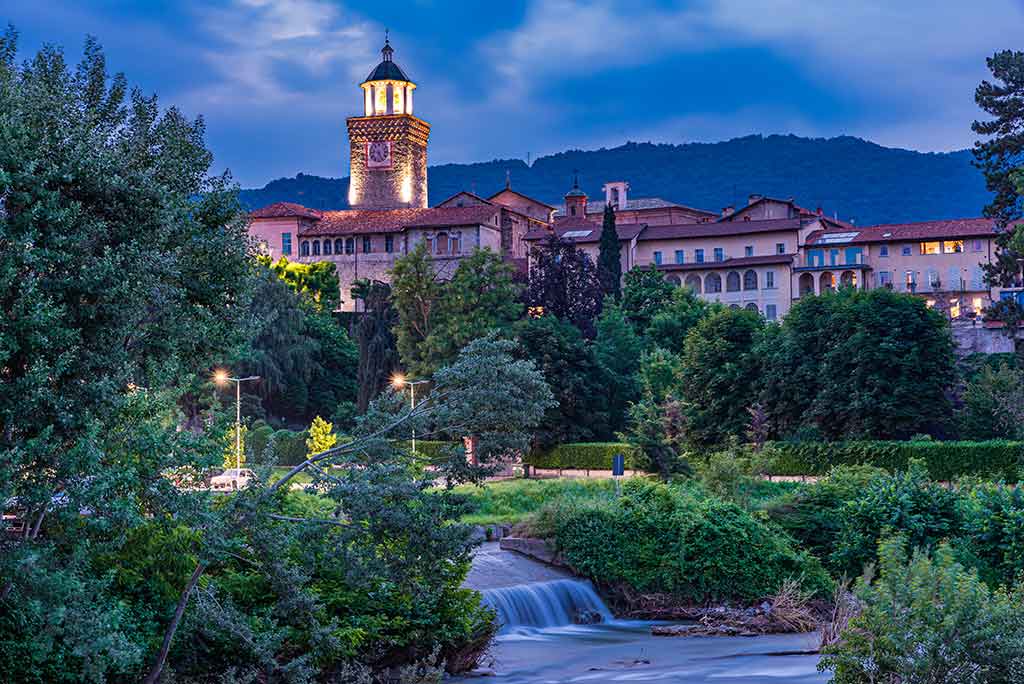
Busca, Cuneo
Busca is a city of ten thousand inhabitants, located in a happy geographical position, at the gates of Cuneo, under Monviso and at the foot of the morainic hill that surrounds it as an amphitheater and which, sheltering it from the cold winds, gives it a mild climate, appreciated since ancient times, consists of a historic center, configured in the space of the ancient medieval walls, and by numerous hamlets, located in the generous surrounding plain. The historic center preserves the medieval urban plan.
The city walls, built in the middle of the '400, equipped with Guelph battlements, is still visible at times. Well preserved Porta Santa Maria, erected between the 15th and 16th centuries, shows the signs of subsequent war events, such as an interesting graffiti undeniable to Louis XIV of France. On the vault of the arch, torn frescoes of Marian themed frescoes could be attributed to the brothers Matteo and Tommaso Biazaci da Busca, who worked between Piedmont and Liguria in the '400: they must have interesting frescoes in at least three churches and chapels from Buschese: Santo Stefano (6th century), San Sebastiano (9th century) and in the Romanesque church of San Martino, located at the top of the homonymous hill.
The Chapel of St. Stephen was built at the origins of local Christianity, between the 6th and 10th centuries, for the community formed around the castle. It was the most important parish of the time. It was restructured several times and raised in the '700. The ancient building remains the splendid apse frescoed by the Biazaci brothers of Busca. On the 'mur de chevet' is painted the Annunciation and the Christ in Sail, between Mary and John weeping. In the apse basin appears the depiction of the theme of primitive catechesis, the tetramorph of Ezekiel with the “Christ Pantocrator” in the world almond and the symbols of the evangelists. Divided into four scenes, the story of the Protomartyr of Saint Stephen is told, taken from the Acts of the Apostles of the Golden Legend. The restoration work, promoted by the City Council in 1998, restored its original splendor to the cycle.
The Romanesque church of San Martino is located on the cucuzzolo of a sunny hill. Built before the Thousand, it has one of the oldest facades of the province of Cuneo, now in its original lines. Erected with squared blocks of green-grey stone, it preserves Roman materials of recovery. The three-ring portal and the overhanging mullioned window recall Carolingian Byzantine forms. The interior has been redone, in the left apse there are traces of paintings of the Byzantine type and in the central one remains of frescoes, unfortunately repainted, a probable work of brothers Matteo and Tommaso Biazaci. The church was raised in the '700.
In the historic center, proceeding beyond Porta Santa Maria, we arrive at the parish church named after the Virgin Mary Assunta, a large eighteenth-century construction by Francesco Gallo.
In the heart of the city, in the historic center, is the Church of the Most Holy Trinity. Built on the ruins a stronghold of the '200 that stood around the ancient tower, of likely Roman origin, today “Torre della Rossa”, or, in Piedmontese, & #39; ''l coché', symbol of the city, together with the bridge that crosses the Maira stream, tributary of a tributary of the Po.
Finally, turning a last look at the lush hill, we have in front of the castle of Roccolo. The castle owes its name to the 'roccoli', nets used here for birds. It was built around 1831 by the Marquis Roberto d'Azeglio in Neo-Gothic style as a holiday palace. Queen Margherita and Silvio Pellico stopped there, after her captivity in Austria. Today it is home to cultural meetings and artistic shows. The spring waters that feed a fountains in the park are famous.
This guide has been translated automatically through a third party service. Visititaly offers these automatic translations to help site visitors, however the automatic translations may contain inaccuracies, errors or inaccuracies. You can contact us to report inaccuracies or errors and we will check the translation.